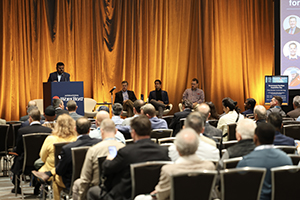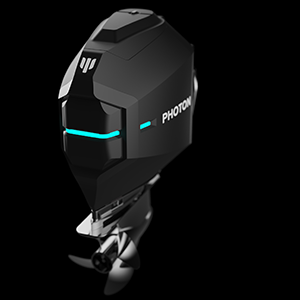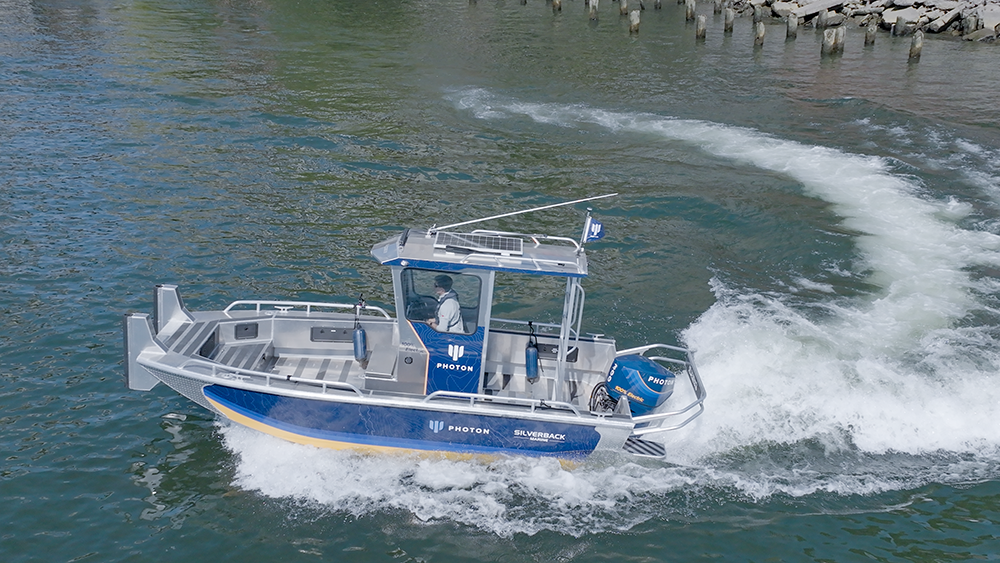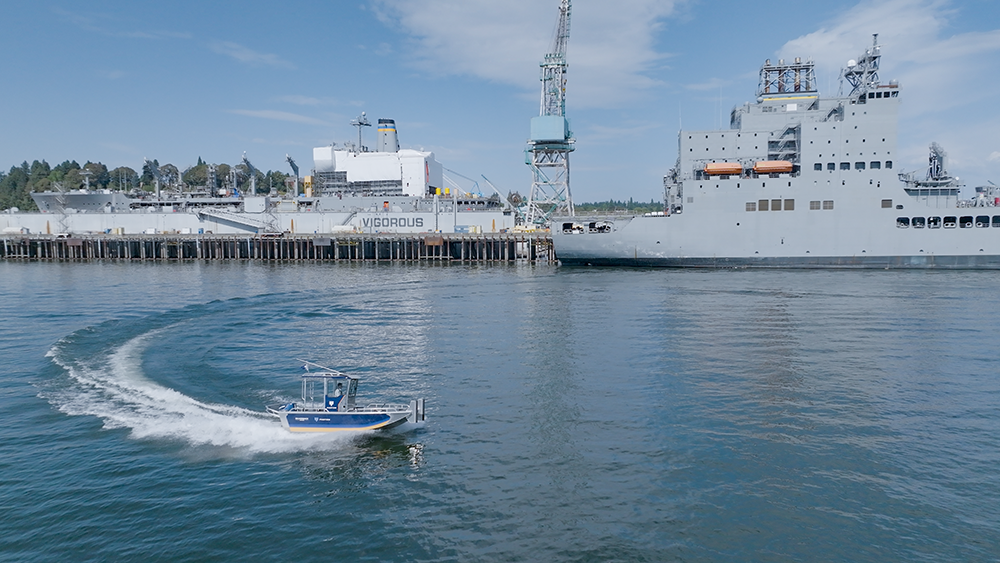Marine electrification was one of the hot topics at the 43rd International WorkBoat Show, with an entire session devoted to exploring what it would mean to chart a course for electrification in marine technologies.
While many have touted the benefits of electric, challenges when it comes to the practicality and viability of such solutions are pervasive. Additionally, electrification has sometimes been positioned as the only way forward, but that sort of mentality represents more of a barrier than a solution. What does it mean to best assess how to move forward today in the context of how the technology and industry will change tomorrow?

At the show, Marcelino Alvarez, CEO of Photon Marine, discussed what he was seeing in the electric outboard arena.
Jeremiah Karpowicz: Marine electrification isn’t a new concept, but there are perceptions and even expectations that have developed around the subject. Can you talk a little bit about those perceptions and expectations, both in terms of how they’ve developed and how things have changed?
Marcelino Alvarez: When most people think about an electric boat, or an electric vessel, they usually think about them in the context of electric vehicles. Depending on what your experiences have been with electric cars, the prospect of an electric boat can either be really exciting, or really daunting.
Part of that is because, by and large, people's experiences with electric vehicles are tied to the availability and limitations of charging infrastructure. And charging infrastructure is going to matter for electric vessels as well. But what’s different and what’s really changed is that it’s a lot easier to devise a charging solution for various kinds of electric vessels that don't require deploying a Tesla-scale Supercharger network. And that’s because many of the vessels going out are coming back to the same spot. So the existing marina infrastructure can support this kind of charging at a scale and level that you’re not getting at home.
That’s compelled a whole new set of questions from owners and operators. What does it mean to have a battery on a boat? What does it mean to charge that battery? How long can you be out on the water with it and how fast can you go? There isn’t one answer to those questions, because it all depends on the context and use case.
So what’s the starting place to sort out where electric can really make sense?
The starting place is to simply identify what you’re currently using the vessel for. If it’s something that's going out and back and has some repeatable stoppage times in between, electric might be a really interesting transition for you. Because you can now charge at the dock and don’t have to deal with what can be a cumbersome refueling process.
That said, if you're doing something like search and rescue and going full throttle 40 miles offshore, or you’re a commercial fisherman that's going for tuna or marlin and need to get from Fort Lauderdale to the Bahamas, electric is absolutely not for you. It's not there yet. And it probably never will be. So that’s why I think all of this needs to start from that very pragmatic place where you’re just talking about what you’re trying to do.
What someone is trying to do is ultimately connected to the power and capability of a vessel, some of which goes back to the perceptions and expectations of electric. Over the past few years, there’s been plenty of chatter about electric just not being powerful enough, but what’s the reality today?
Our technology has a 300-horsepower motor, with continuous output closer to 150. We’ll get to the point where you could throw a 600-horsepower electric motor onto a boat, but right now, you're going to need a lot of batteries to power it, and not all designs are going to be able to support that weight.
Honestly, I don't think that those kind of 600-horsepower electric motors are here to stay for commercial applications. Do they need that much weight or that much horsepower to move a vessel through the water? I think it’s possible to go higher in horsepower but changes there will be a consequence of developments with new battery tech. The battery tech is something to keep an eye on because it's certainly evolved and it’s going to continue to evolve.
That’s tied to your mention of industry chatter about electric not being powerful enough. I think the people that say batteries aren't sufficient are looking at batteries today instead of where they’re going. There are plenty of studies that outline how battery densities are increasing 4% to 5% every year. Additionally, companies are developing propellers that could enable 30% more efficiency. Others are developing what is basically a hovercraft-type device that pushes your vessel a little bit off the water to add that much more range. All of that is just to say there are going to be tons of products that can be added after-market, or as part of the whole design, that are going to increase range to better meet the needs of a vessel or operation. Batteries are in a state of transition that is just part of a larger shift.
Which includes the future of various other alternative fuels and means of propulsion.
Yes, and I think there’s plenty of room for fuel cells and hydrogen. And I think for some applications, the energy stock or an electric vessel might be a fuel cell. We’re very much in a state of transition, but that's not an excuse to not move forward. I think that's a reason to experiment and understand what's possible today, knowing that by the time the battery hits its end of life, you might have a battery that's two to three times more energy-dense.
People often get caught up with the upfront costs around the adoption or integration of these systems, but I think what's getting lost in the conversation is how much an operator spending on oil changes and taking the vessel out in the water to do routine maintenance today. Do the outboard motors have to go through their maintenance cycles every 100 hours or every 300 hours? With an electric system, we're targeting a 1000-hour maintenance window.

How any of these new systems or technologies compare to what someone is currently doing is what you talked about on stage with your mention of Photon’s P300 prototype test that would have been four to five times more with a gas engine. Can you talk a bit more about this kind of bottom-line difference?
A traditional 100-300 horsepower motor might cost you $30k up front. Over a seven-year period, you're probably replacing that at least once if you're a commercial operator, but we’ve talked with plenty of commercial operators who replace their motors every other year, so they can sell it with one year remaining on its warranty. That’s additional time and expense. You're also paying for oil changes, impeller replacements, and the sparkplug changes the entire time. All of that adds up to the point that over a seven year lifetime, you might spend north of $300k. And that probably doesn't even factor in the lost revenue from not being on the water when it needs that maintenance or you’re in the middle of selling or replacing the motor.
A comparable electric system probably costs half of that, with charging being something that is use case and location dependent. What is the electricity cost where you're going to be using your system? But also, what are the fuel costs? In places like the Pacific Northwest, electricity is super cheap, and we pay eight cents per kilowatt in Portland. On the other side of that, we spend close to $6 per gallon for marine fuel.
In those circumstances, your payback period could be within two years. At the same time, you've got a place like Alaska, where it's a bit more seasonal, so you might be looking at a longer payback period. In places like Hawaii though, where your fuel is really expensive, it could also have a longer payback period. Though in Hawaii, pairing our solution with solar and microgrids could shorten the payback period.
Is that something you can figure out with the right info?
It's something that we'll model out for our customers based on four or five inputs. Most people know what their business costs them per hour in oil. They know exactly what the cost structure is of their business. We can use all of that as a baseline, so when you present them with an easier maintenance cycle that doesn't require them taking the boat out of the water for a few weeks at a time, they can understand and literally see the difference on paper.
Some of that is connected to the capabilities, because there’s so much focus on a single horsepower number. They have 300 so they want 300. Or more. But how much of that are you actually using? I can’t tell you how many people say they’re using all 300, but we get out on the water and see they’re not even using half of that. But that's what they're comfortable buying, because that's what they've been told they needed to buy all these years. But what do you really need? That’s part of the awareness and education we’re trying to promote, because it really can pencil out.
Most customers are purely motivated by the economics of it, which is totally understandable, but also makes it so that it isn't an emotional decision to switch to electric. It's an economic one that can be further influenced by less qualitative factors, like an ambitious ESG commitment or noise reduction. We've talked to several old-time operators that are hard of hearing, because they've spent a lifetime on a boat. The opportunity to have a silent system creates benefits for people and the environment in a way that isn’t part of the normal conversation and goes beyond the bottom line.

Randy Fenton, marine infrastructure manager at New York Power Authority Canals (NYPAC), witnessed your engine’s performance firsthand. What kind of a difference did that make, and is it something you’d encourage others to experience?
Something like 70% of electric car purchase decisions were motivated by a test drive and I think we’re going to see a similar dynamic with electric motors. Marine people have to see it to believe it, and once they do, their perspective can change in a big way.
The New York Power Authority has a long history of innovation, and they have some state-driven mandates that are pushing them to explore new tech. That’s also why Randy wanted to learn more. Can this boat perform? Can it do what it needs to do? And he wanted those answers specifically, which is why he went through the process to get the vessel out for a week of operations on the Erie Canal.
So we went through a public RFP process to make that happen, provided a bit of training and handed over the keys to the operators, allowing them to do things like move supplies from lock 19 to lock 20. That's what they were evaluating, but there were also very basic practicalities that this kind of hands-on experience compels. Like, where do you store this in the winter? We’re talking about upstate New York, where it’s literally freezing. In this case, we determined that we could install a heater to keep the battery warm if they couldn’t store it in a place that was weatherized. So going hands-on can be revealing on multiple levels.
That kind of “hands-on” experience might not be available to everyone, but what advice would you have for someone that wanted to get their arms around what's possible right now? What info should someone arm themselves with to sort out what’s possible?
I think it's going to be difficult to evaluate electric without experiencing electric. So to the extent that we can, we always want to make sea trials available.
When it comes to assessing what’s possible, the best thing you can do is outline what your fleet looks like right now. To detail the different vessels that are in your fleet and what those boats do on a regular day. And then when it's coming time to replace or repower, you can say, “I'm spending a lot of fuel on this one,” or “I hear that maybe there's electric out there, could this one be right for it?”
And then honestly, it’s just a conversation to sort out the needs, how often you’re replacing your outboard, what maintenance currently looks like, etc. What are some of the pain points in your life that you're not really thinking about as pain points because you've assumed that that's the only way to be?
With that info, you can get feedback along the lines of, “Great, of these 10 vessels, three or four might be really good candidates for electric, so let’s work that all the way through.”
Great advice. To wrap things up, I wanted to ask about what you’re hoping to see develop or take shape with all of this in 2024. What has you especially excited about the changes we could or will see this year?
We’re incredibly excited to see the infrastructure around electrification and transitions take shape in places like Alaska, but for us, what we’re looking forward to is a change around how people are looking at hybrid electric outboards. More people are beginning to recognize that there are other technologies that can suit goals around having cleaner systems.
What’s also neat is that for commercial operators, there are a lot of incentives that are coming that are going to make it easier for them to make that switch. Whether that's clean fuel subsidies or grant opportunities, there’s a lot coming down the pike where the upfront cost of electric can be mitigated. These are things that can really accelerate the cost of ownership, meaning the payback period goes from perhaps two and a half years to quite a bit less.
Really though, what I’m looking forward to is being able to empower more people to become evangelists for the technology. Ultimately, our interest isn't in selling you a thing, but is more about turning you into an advocate for what electric can be. We want to give our customers the tools and resources to feel confident in their purchase decision, but then also become an evangelist and say, “this is great because it's going to change the cost structure of running your commercial boat operation.” We’re still in the early stages of electrification, which means most boat builders are sticking a battery and a motor onto the vessel. But I think we’ll see more novel hull designs this year, to the point that rather than looking at it as a retrofit opportunity, we’ll see builds that optimize a hull l for electric to get both performance and range out of it. It's just a different dynamic than a gas system.
The goal for an outboard motor is to consume and I think the goal for an electric system is to preserve. There are just a lot of opportunities to do things that we haven't done with gas motors. I think we can create systems that intelligently help you preserve while also meeting your needs. And that’s really exciting.




